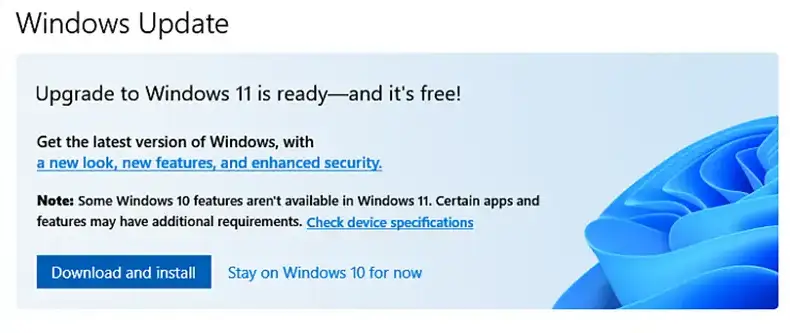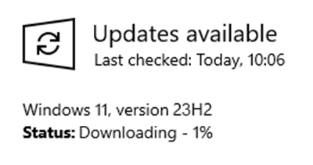Come October 2025, Windows 10 will no longer be supported by Microsoft.
Support for Windows 10 will end on October 14, 2025, with paid for support and security patching ending in October 2028.
This could represent a serious cyber security risk to the university, and as such, we are now moving to Windows 11.
Upgrading to Windows 11 will ensure users are supported with the latest Microsoft features, security patches, and functionality to support collaborations, teaching and learning. For further information on the benefits of Windows 11, please see the section at the bottom of this page.
If your QUB computer is capable of running Windows 11 it will automatically be installed through Microsoft updates. To check if Windows 11 is ready to be installed on your device, click on the Start button and choose Settings. Click on the Windows Update option and then select Check for Updates.
- This upgrade will not wipe the machine and your software/files should remain unaffected, however we strongly recommend following best practice by ensuring any important files are backed up to University cloud storage (Microsoft OneDrive/SharePoint/Q drive).
- Any new devices purchased from Dell will be shipped with Windows 11 by default.
If Windows 11 is ready to be installed on your computer, you should see the update option as shown below:

Click on Download and Install
Windows 11 should start downloading automatically. You will see the progress of the download displayed as below. During the download you can close the page and continue working as normal. To check on its progress, return to the Microsoft Update section as before. Installation of Windows 11, including updates, can take from 3 to 6 hours to complete. As mentioned above, you can work away as normal during this time.

When the download is complete, it will automatically be installed. Again, the progress will be displayed as below:

You will need to Restart your device a number of times during the installation process. When necessary, you will see a message on your update page asking you to Restart.

After restarting, log in again as normal. When the update process is complete you should see Windows 11 on your device.
After the installation is complete, you should go back and Check for Updates again, as there will most likely be further updates and patches for Windows 11.
The pages below cover the benefits of Windows 11 and what to do should you require support.
-
Benefits of Windows 11
Windows 11 is easier to use, easier to be productive, easier to be safe and easier to play. Find out more on Microsoft's webpages.
Taskbar: Quickly get to your favourite apps, see the time, and more, right from the taskbar. For more info, see How to use the taskbar in Windows.
Search: Find files, people, settings, and more from Search on the taskbar. Or, select Windows logo key + S. For more info, see Search for anything, anywhere.
Dark mode: Make your screen easier on the eyes with dark mode. Select Start > Settings > Personalisation > Colours . Then, next to Choose your mode, choose from dark, light, or custom modes.
Tabs in File Explorer: Just like a browser, you can open multiple tabs on File Explorer and quickly move files between tabs. Select Windows logo key + E to open File Explorer. For more info, see Find and open File Explorer.
Notepad: Jot down ideas in Notepad—you can now use it with in dark mode or even switch your fonts.
Snipping Tool: To capture an image from your screen, select Windows logo key + Shift + S. For more info, see Open Snipping Tool and take a screenshot.
- Windows 11 FAQs and support
Installation support
The Service Desk will be on hand to help staff members with the move to Windows 11. Please call 5050 or email itservicedesk@qub.ac.uk for further assistance.
Using Windows 11
If you need help using Windows 11, check the Microsoft Windows 11 Help Centre or watch the videos from the Windows 11 Essential Training course on LinkedIn Learning for step-by-step guides of the features in Windows 11.
FAQs
I'm still using Windows 10, what happens after 14 October 2025?
on 14 October 2025, Microsoft will no longer support Windows 10, unless under paid for extended support. University laptops and desktops which are on Windows 10 without extended support after October 2025 pose a security risk.
Digital & Information Services (DIS) are working with the university community to ensure that devices running Windows 10 are either upgraded or replaced with as little disruption as possible.
How to check what version of Windows my device is operating?
To find out which version of Windows your device is running select the 'Start Menu> Settings> System> About'. Under 'Windows specifications', check which edition and version of Windows your device is running. For more information visit Microsoft support web pages.
What are Supported/Unsupported Devices?
Unsupported devices are those where our university approved vendor, Dell, has ceased support on the version of the operating system we are targeting.
When does a device qualify for an upgrade?
If your device is on Windows 10, and is still within support of Dell, we will upgrade the operating system to Windows 11. If your device is on Windows 10 and no longer supported by Dell, your school/directorate will need to replace the device.
Last Updated: July 2024
